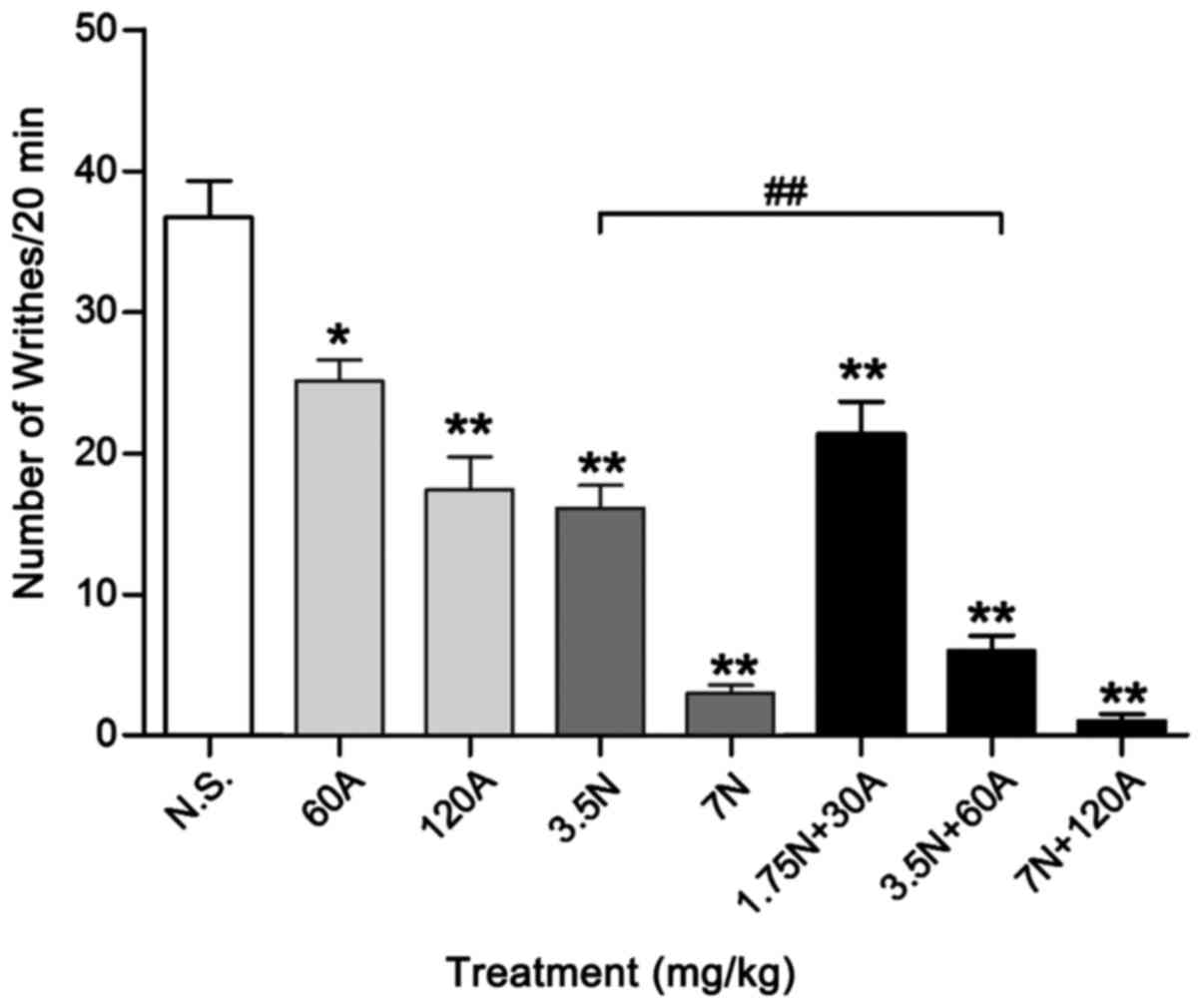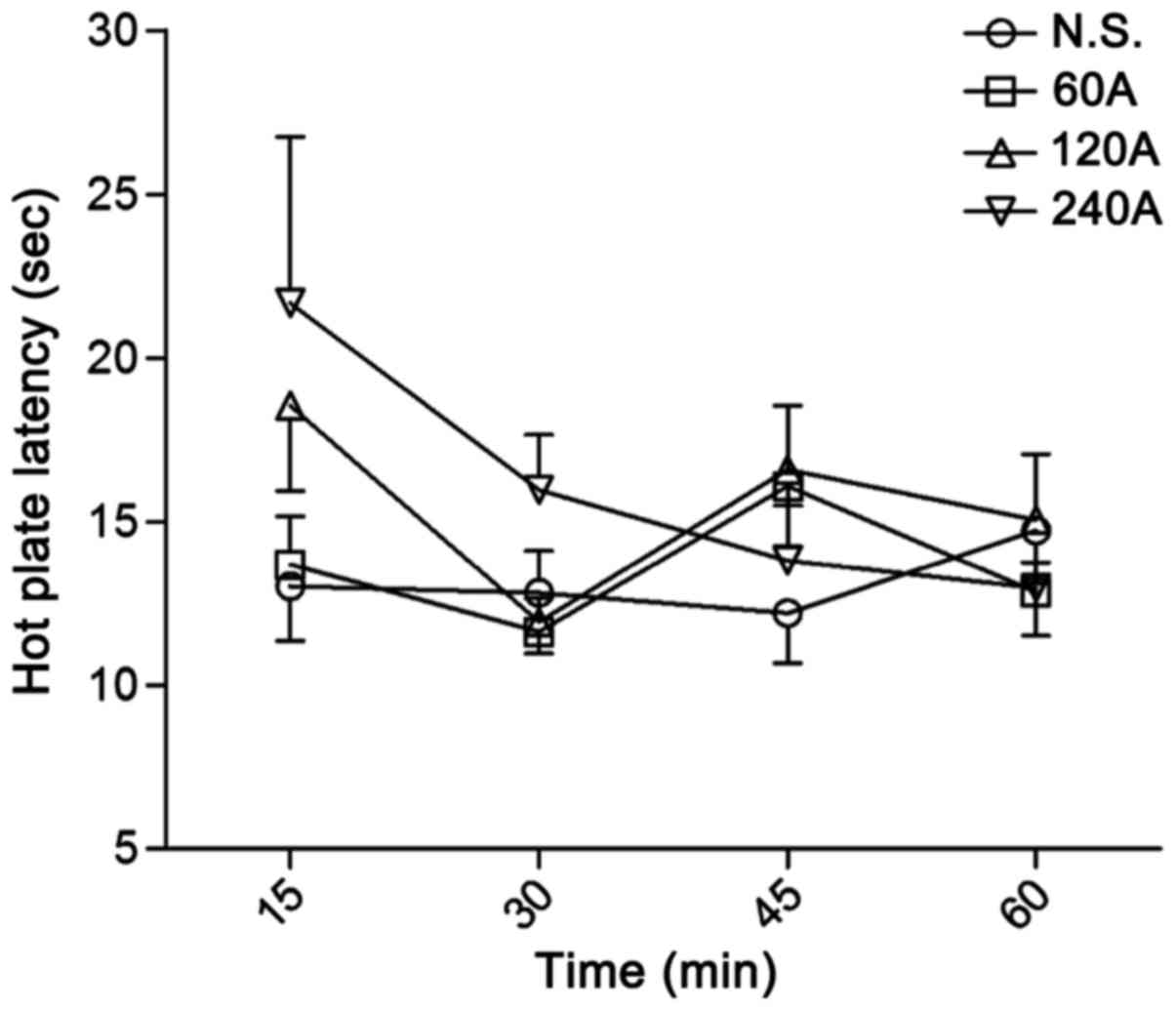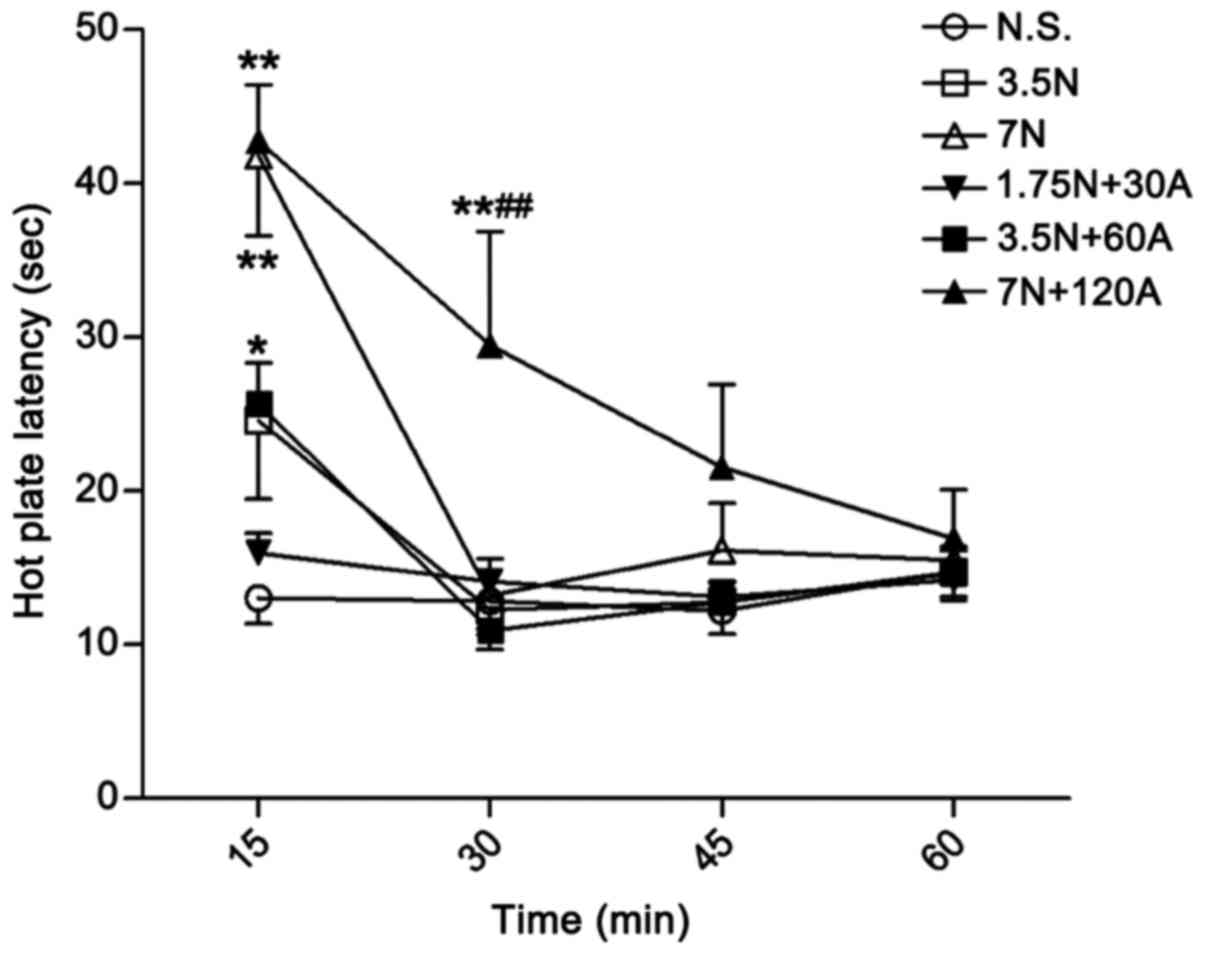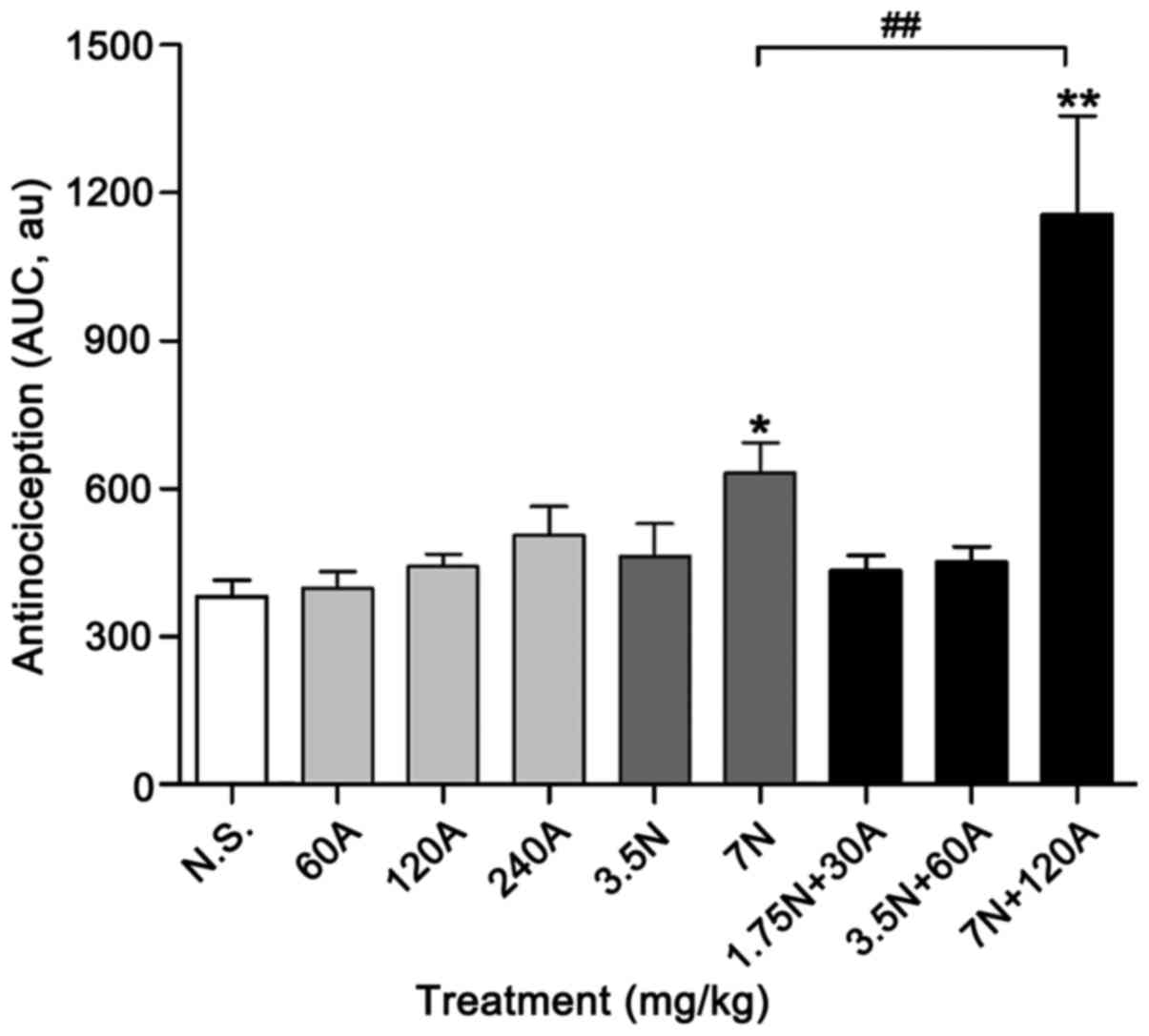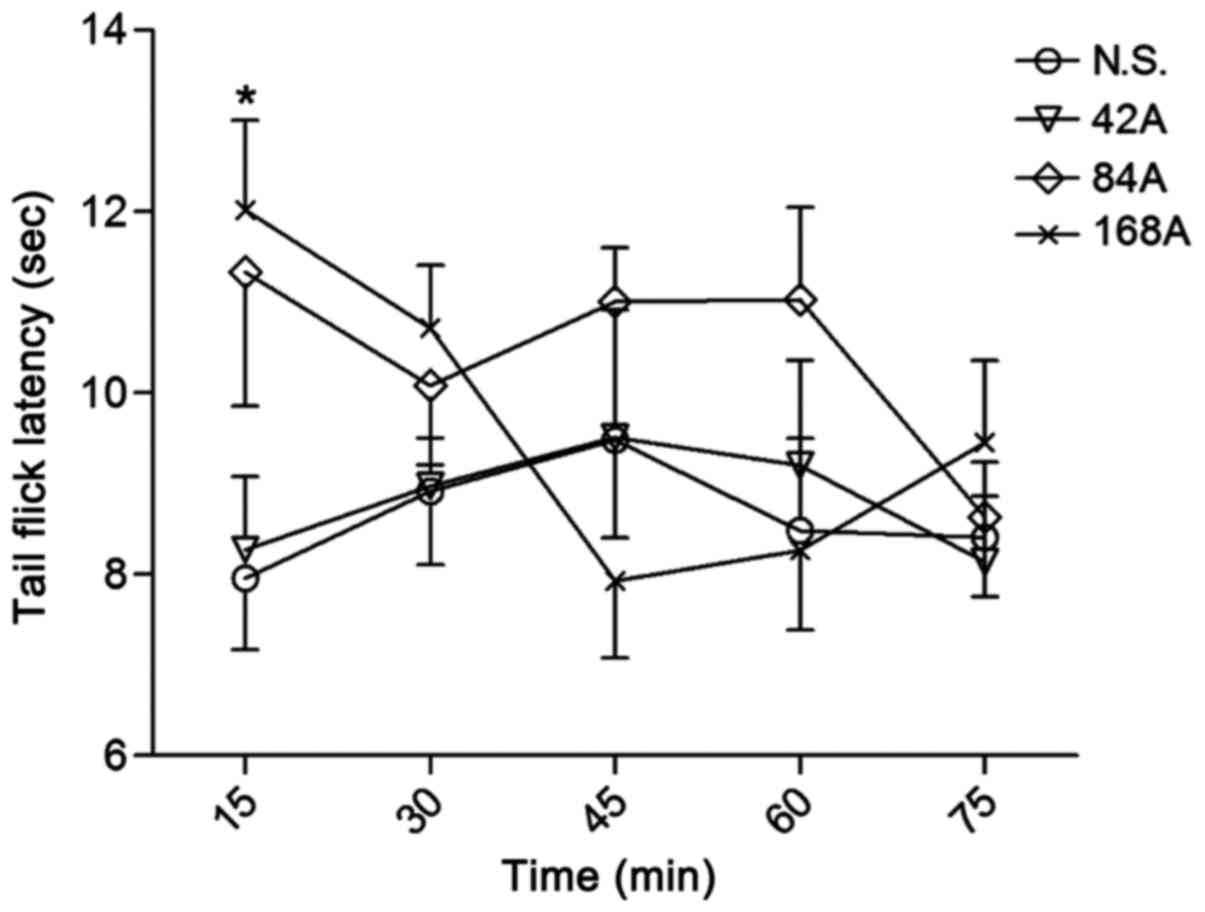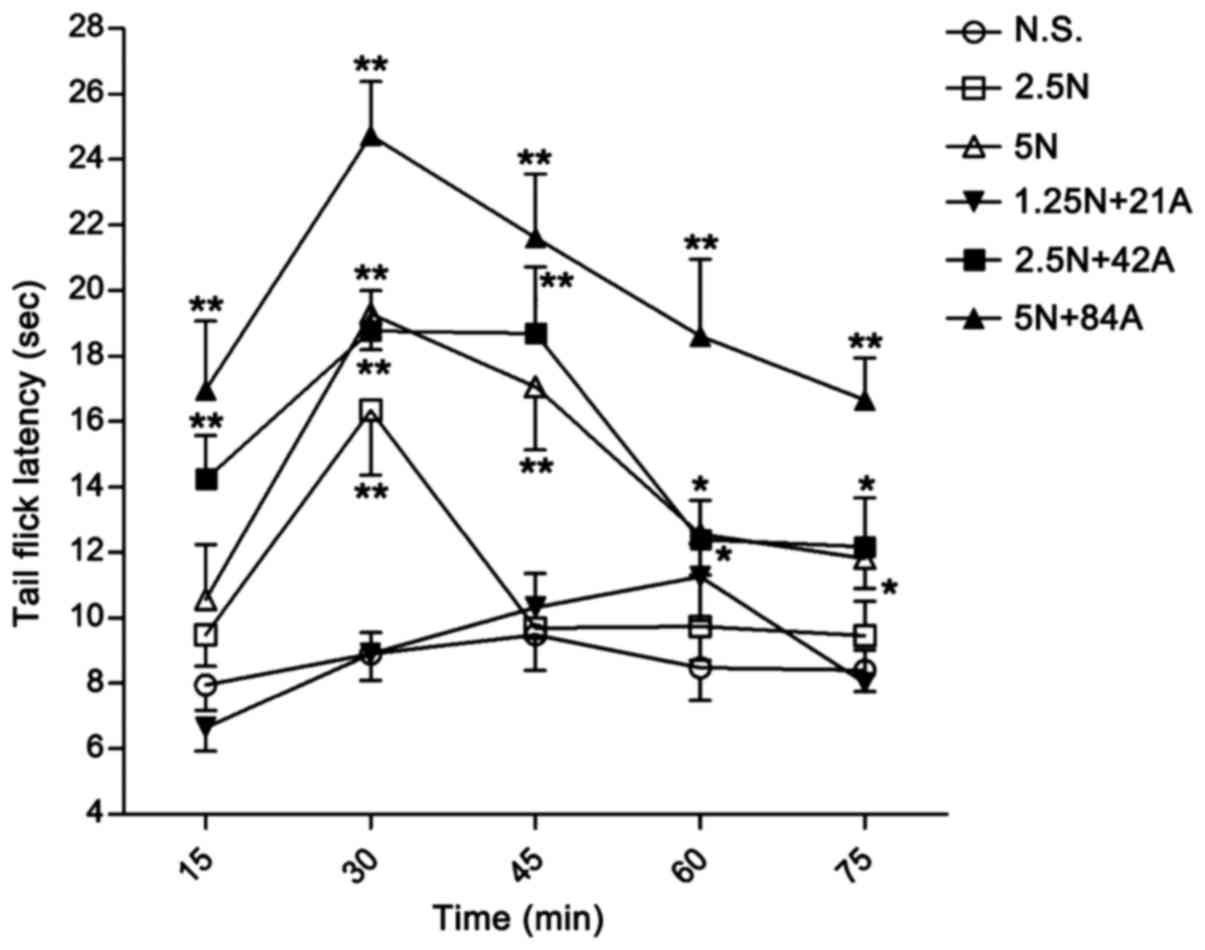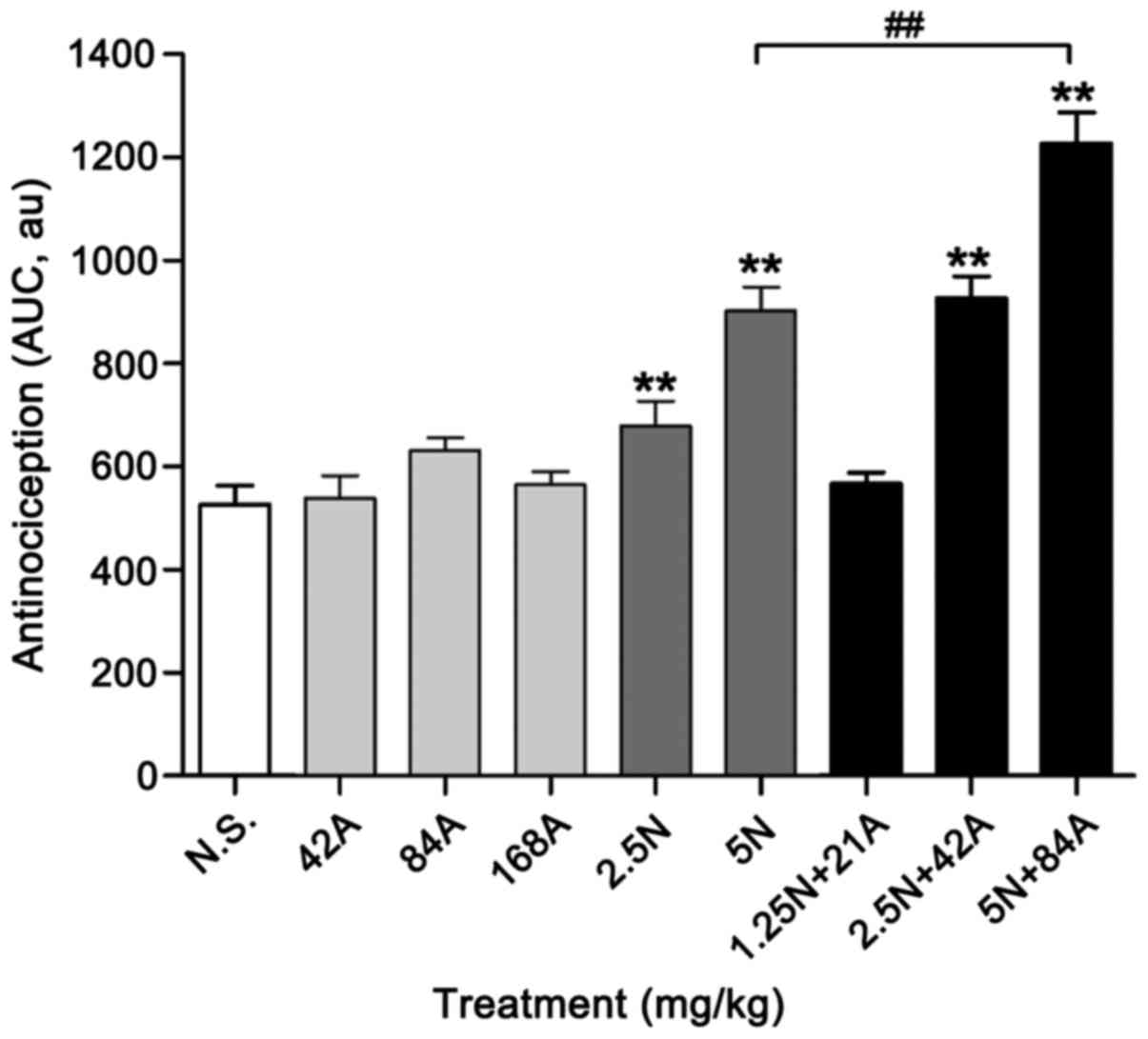Enhanced analgesic effects of nefopam in combination with acetaminophen in rodents
- Authors:
- Published online on: December 18, 2017 https://doi.org/10.3892/br.2017.1032
- Pages: 176-183
Abstract
Introduction
Nefopam is a novel type of analgesic drug that exerts non-narcotic effects (1), and thus differs from typical opioids and anti-inflammatory drugs (2). Nevertheless, it effectively elicits antinociception in the majority of noxious and thermal models in rodents (3,4). The mechanisms of action of nefopam may involve inhibition of monoamine reuptake in the central nervous system and glutamatergic pathway, in which calcium channels serve a role (5,6). Certain adverse reactions of nefopam, including dizziness, headache, nausea, vomiting and sweating, have been associated with its central mechanisms (7).
Non-steroid anti-inflammatory drugs (NSAIDs) are clinically used in the management of chronic, inflammatory and postoperative pains. They may inhibit cyclooxygenase (COX) enzyme that catalyzes the conversion of arachidonic acid to generate prostaglandins (PGs) (8–10). PGs are established to serve a role in pain and inflammatory processes (11). Acetaminophen is among the most commonly used analgesic and antipyretic drugs worldwide, either on prescription or over the counter. The drug has generally replaced aspirin and other salicylates in the treatment of mild to moderate pains in conditions without inflammatory involvement, including headache, toothache and dysmenorrhea (12,13). However, the mechanisms of its action remain to be fully defined. The antinociceptive effects of acetaminophen may occur in part through inhibition of the central COX enzymes COX-2 and COX-3 (14).
Results from other studies on the underlying mechanisms have also indicated the involvement of other receptors and transmitters in the central nervous system (15,16). The side effects of NSAIDs most commonly include gastrointestinal problems, hepatotoxicity and nephrotoxicity (17).
In consideration of the proposed individual mechanisms of nefopam and acetaminophen, the present study aimed to investigate the analgesic efficacy of combined therapy with the two drugs, and to determine whether it is possible to reduce the dose of nefopam used. Three animal models were used: The first involved intraperitoneal administration of acetic acid (AA) in mice, which simulates acute inflammatory pain in the viscera and induces abdominal writhing; the second and third models involved simulation of acute thermal pains, evaluated through hot plate and tail flick tests. Assessments of these models ultimately aimed to determine the effects of combined drug therapy compared with nefopam alone.
Materials and methods
Animals
The present animal experiments were conducted according to the rules of animal experimentation and the Guide for the Care and Use of Laboratory Animals of Shenyang Pharmaceutical University (Shenyang, China), and the protocol was approved by the Animal Ethics Committee of Shenyang Pharmaceutical University (approval no: SYPU-IACUC-131220-138). The animals used were Kunming mice aged 4–6 weeks old (n=249; male and/or female depending on the assay as specified) and Sprague-Dawley male rats aged 6–8 weeks old (n=77; sex ratio 1:1), obtained from the Animal Center of Shenyang Pharmaceutical University. The animal weights ranged between 18–25 g for mice and 180–250 g for rats. The animals were group-housed (6 mice per cage) under standard environmental conditions (22±1°C, humidity 60±5%, 12 h light/dark cycle) with free access to a standard commercial diet and water ad libitum. After a 7 day adaptation period, all experiments were performed during the light phase.
Drugs
Nefopam hydrochloride and acetaminophen were provided by Shenyang Funing Pharmaceuticals Co., Ltd. (Shenyang, China). They were dissolved in 0.9% sterile saline (normal saline, N.S.; Shenyang Zhiying Pharmaceutical Co., Ltd., Shenyang, China). Nefopam and acetaminophen were intravenously (i.v.) administered at a constant volume of 10 ml/kg body mass in the abdominal constriction and hot plate tests, while the drugs were intraperitoneally (i.p.) injected (10 ml/kg) in the rat tail flick test to prevent tail pain from i.v. injection.
Determination of optimal drug combination through orthogonal design
The orthogonal array method was used to optimize the proportions of nefopam and acetaminophen (18–20). In brief, the L9 (32) factorial design, a factorial arrangement with two factors at three levels, was used to indicate the optimal proportions of nefopam and acetaminophen in combination (Table I). The detailed experimental design is presented in Table II.
The analgesic activity of each combination was evaluated through a preliminary abdominal constriction assay in mice (21). Mice were randomized into 9 groups (n=10, sex ratio 1:1) and were respectively administered the combinations of nefopam and acetaminophen (i.v.) according to the design in Tables I and II. After 30 min, each mouse was injected (i.p.) with 0.8% AA and was placed in an individual plastic cage for observation. The number of writhing responses in a 20 min observation period was counted by an investigator blinded to the experimental groups, beginning 3 min after administration of the AA solution. A writhing response was characterized as a wave of contraction of the abdominal musculature followed by extension of the hind limbs.
Abdominal constriction assay in mice
Subsequently, persistent chemical pain was assessed by abdominal constriction assay in mice. In the present test, male and female mice (sex ratio 1:1) were used, randomized into 8 groups. The mice were respectively administered (i.v.) 0.9% N.S. (n=10), nefopam (3.5 and 7.0 mg/kg; n=9 and 10), acetaminophen (60 and 120 mg/kg; n=9 and 10) or combinations of nefopam (N) and acetaminophen (A) (1.75 N + 30 A, 3.5 N + 60 A, 7.0 N + 120 A mg/kg; n=8, 10 and 8) 30 min prior to the abdominal constriction test. Each mouse was injected (i.p.) with 0.8% AA at the start of the test and was placed in an individual plastic cage for observation. The number of writhing responses in a 20 min observation period was counted as described above.
Hot plate test in mice
An RB-200 intelligent hot plate apparatus (Chengdu Taimeng Science And Technology Co., Ltd., Chengdu, China) was used. The temperature of the hot plate was set to 55±0.5°C and latency was defined as the period from the time when the animal was placed on the hot plate surface to the time when the animal licked its back paw or jumped off to avoid thermal pain. Female mice were used. The mice with latency of 5–30 sec by duplicated detection were selected to be used in the formal experiment (21). The mice were randomized into 9 groups and were respectively administered (i.v.) 0.9% N.S. (n=9), nefopam (3.5 and 7.0 mg/kg; n=9 per group), acetaminophen (60, 120 and 240 mg/kg; n=10, 10 and 9) or combinations of N and A (1.75 N + 30 A, 3.5 N + 60 A, 7.0 N + 120 A mg/kg; n=9, 10 and 10). The latency of hind paw licking was measured at 15, 30, 45 and 60 min after the test compounds were administered. A maximal latency of 60 sec was used to avoid damage to animal skin tissues for any mice exhibiting thermal pain endurance.
Tail flick test in rats
A tail flick assay in rats was performed as described in our previous study (21), for which an automated tail flick test device (SW-200 Analgesia Meter; Chengdu Taimeng Science And Technology Co., Ltd.) was used. Rat tails (distal 1/3rd) were painted with black ink to enhance absorption of heat radiation. An adjustable heat source was directly placed under the tail. The assay is based on the animal flicking its tail away to avoid pain induced by the source of heat. Tail flick latencies required for the rat to remove its tail were determined in sec as an index of nociceptive threshold (22). Pain threshold elongation indicated the analgesic effect of the drug. The rats with latency of 3–20 sec by duplicated detection were selected to be used in the formal experiment. They were randomized into 9 groups and were respectively administered (i.p.) 0.9% N.S. (n=9), nefopam (2.5 and 5 mg/kg; n=9 per group), acetaminophen (42, 84 and 168 mg/kg; n=8 per group), or combinations of N and A (1.25 N + 21 A, 2.5 N + 42 A, 5.0 N +84 A mg/kg; n=9,9 and 8) prior to their subjection to the tail flick test. The latency of tail flicking was determined at 15, 30, 45, 60 and 75 min after drug administration. The maximal latency was limited to 30 sec to protect tail tissues from damage in instances of thermal pain endurance.
Statistical analysis
Results from the groups were calculated as the mean ± standard error of mean. Statistical analysis was performed with one-way analysis of variance and post hoc multiple comparison between groups was performed with Fisher's protected least significant difference test to compare the data, which were analyzed with SPSS 16.0 software (SPSS, Inc., Chicago, IL, USA). Cumulative antinociceptive effect during the whole observation period was determined according to the area under the curve (AUC) of the temporal course to compare the complete antinociceptive effects exerted by the tested drugs, alone or in combination. The value of AUC was calculated with SigmaPlot 12.0 (Systat Software, Inc., San Jose, CA, USA).
Results
Optimization of the proportion of nefopam and acetami nophen
Three dose levels of individual doses of nefopam and acetaminophen were represented by 1, 2 and 3, respectively (Table I). The number of writhing responses was determined to evaluate the analgesic effect of each combination. Ki (i =1, 2, 3) represented the sum of writhing responses for nefopam or acetaminophen at each level. Considering that a reduced number of writhing responses indicated a higher analgesic effect, the lower the value of Ki, the greater the analgesic effect. The drug with higher R value was considered to have a greater impact on the analgesic effect. As depicted in Table II, nefopam was the main factor influencing the analgesic effect of combination therapy. The optimal formula for nefopam was the third level (3.5 mg/kg) and for acetaminophen the first level (60 mg/kg). Based on the results under orthogonal design conditions, the optimum proportions of the two drugs were indicated to be 3.5 mg/kg nefopam plus 60 mg/kg acetaminophen (Table II).
Antinociceptive effect on writhing response in mice
The combinations of 1.75 N + 30 A, 3.5 N + 60 A and 7.0 N + 120 A mg/kg evoked antinociception dose-dependently in the abdominal constriction assay (Fig. 1); writhing response number in each group was 21.4±2.26, 6.0±1.05 and 1.0±0.50, respectively. Acetaminophen used alone at a dose of 60 mg/kg elicited significant antinociception, with writhing number reduced to 25.1±1.49 during the 20 min period (P<0.05), while 3.5 mg/kg nefopam reduced writhing number to 16.1±1.61 (P<0.01), compared with 0.9% N.S. control (36.7±2.58). Co-injection of 3.5 mg/kg nefopam plus 60 mg/kg antinociception (combination 3.5 N + 60 A mg/kg) significantly reduced the number of writhing responses by 63% (to 6.0±1.05) compared with that of 3.5 mg/kg nefopam alone (P<0.01). High-dose nefopam (7.0 mg/kg) exhibited significant analgesic efficacy with a writhing response number of 3.0±0.58, as did the high-dose combination treatment (7.0 N+120 A mg/kg; 1.0±0.5), relative to N.S. control (P<0.01). The high-dose combination decreased the number of writhing responses by 66% compared with high-dose nefopam alone, though there was no significant difference between the groups. Additionally, there was no significant difference in analgesic effect between the optimum combination (3.5 N + 60 A mg/kg) and high-dose nefopam treatments (Fig. 1).
Antinociceptive effect on hot plate latency in mice
Acetaminophen alone did not exhibit significant antinociceptive activity in the hot plate assay even at a high dose of 240 mg/kg (Fig. 2), and neither did the low dose of nefopam (3.5 mg/kg; Fig. 3). The combination 3.5 N + 60 A mg/kg exerted a significant antinociceptive effect at 15 min when compared with N.S. control (P<0.05; Fig. 3). The analgesic effect of high-dose nefopam (7.0 mg/kg) alone was significant at 15 min when compared with that of the control (P<0.01), though was not sustained at time points thereafter (Fig. 3). By contrast, the high-dose combination (7 N + 120 A mg/kg) was identified to produce a significant analgesic effect up to 30 min after administration compared with the control (P<0.01; Fig. 3). Furthermore, the high-dose combination exerted greater antinociceptive activity at 30 min compared with high-dose nefopam alone (P<0.01; Fig. 3).
The cumulative effect of nefopam or acetaminophen administered individually or in combination, expressed as the AUC of the temporal course, also indicated the different antinociceptive properties of the drugs used alone and in combination (Fig. 4). According to AUC values, acetaminophen at doses of 60, 120 and 240 mg/kg did not exhibit significant antinociceptive activity in the hot plate assay, though exerted dose-dependent effects; the area units (AU) were 397.81±34.81, 442.54±82.59 and 505.85±58.09, respectively (Fig. 4). The high-dose combination (7 N + 120 A mg/kg) exhibited a greater cumulative antinociceptive effect during the whole observation period (60 min), with an AUC value of 1,156.95±199.30 AU, compared with that of high-dose nefopam (7 mg/kg) alone (632.12±62.38 AU; P<0.01). Nevertheless, both high-dose nefopam and combination exhibited significant cumulative antinociception compared with the N.S. control (381.6±33.9 AU; P<0.05 and P<0.01, respectively; Fig. 4).
Antinociceptive effect on thermal tail flick latency in rats
The highest dose of acetaminophen (168 mg/kg) exhibited significant antinociceptive activity in the tail-flick test at 15 min after drug administration (P<0.05), while the lower doses (42 and 84 mg/kg) had no significant analgesic effect, relative to N.S. control (Fig. 5). Nefopam alone exerted a sustained analgesic effect at a dose of 5.0 mg/kg, which was significant at 30 (P<0.01), 45 (P<0.01), 60 (P<0.05) and 75 min (P<0.05; Fig. 6); while the lower dose of the drug (2.5 mg/kg) only exerted significant analgesic effect at 30 min (P<0.01; Fig. 6). By contrast, 42 mg/kg acetaminophen combined with 2.5 mg/kg nefopam (combination 2.5 N + 42 A mg/kg) exerted a significant analgesic effect on tail flick latency compared with the control at all time points (P<0.05), particularly between 15–45 min (P<0.01; Fig. 6). This antinociceptive effect was maximized by co-injection of 5 mg/kg nefopam and 84 mg/kg acetaminophen (combination 5 N + 84 A mg/kg) throughout the observation period (P<0.01); additionally, maximum effect of the 5 N + 84 A mg/kg combination was observed at 30 min after drug administration (Fig. 6). The combinations of nefopam with acetaminophen produced greater antinociceptive effect than that obtained by administration of the corresponding nefopam concentration alone, and the analgesic effect of the combination treatments occurred in a dose-dependent manner (Fig. 6). The sustained effects over 75 min were subsequently expressed with AUC values, which verified the assay results (Fig. 7). Notably, both monotherapy and combined therapy exhibited antinociceptive effects in a dose-dependent manner, and the higher dose combination (5 N + 84 A mg/kg) exerted greater analgesic effect compared with the higher dose of nefopam (5 mg/kg) alone (P<0.05; Fig. 7).
Discussion
The main purpose for the development of combination analgesics is to gain further efficacy and potency, and to thus doses. It has been demonstrated that nefopam has synergistic analgesic effects in humans and rodent animals when administered concomitantly with nonsteroidal anti-inflammatory drugs (3,23–25). A previous clinical trial indicated that a combination of nefopam and ketoprofen produced effective analgesia with synergistic interaction in humans (23). Elstraete and Sitbon (24) reported that the combination of nefopam and acetaminophen produced effective analgesia with a synergistic interaction allowing a dose reduction of each drug. Furthermore, it has been observed that coadministration of nefopam with ketoprofen or paracetamol has synergistic effects in rats with carrageenan-induced tactile allodynia, in the inflammatory phase of the mouse formalin test, in thermal hyperalgesia in an incision model of postoperative pain, and in the abdominal writhing response in the AA test (3,25). The present study verified an additive potentiation of acetaminophen and nefopam at the tested doses when compared to their per se effect in rodents, and this positive combination allowed dose reduction of each drug.
AA induces a writhing response when it is intraperitoneally administered (26,27). It has been reported that the agent may cause the indirect release of noxious substances including bradykinins, serotonin, histamine and PGs (28–30). The severity of abdominal constriction induced by AA may be dependent on the production and release of pro-inflammatory cytokines from resident peritoneal macrophages and mast cells (31,32). Although the abdominal constriction test is considered a sensitive method for investigating the stimulation of local receptors in the abdomen, it is also considered non-specific as the observed analgesic effects can not be ascertained to involve a peripheral and/or central mechanism (33). In the present study, acetaminophen, nefopam and their combinations produced significant antinociceptive effects in this visceral inflammatory model in mice. The mechanism of action may be dependent on both peripheral and/or central pathways.
Hot plate and tail flick tests were also performed to confirm the additive effect of the two drugs in the present study. The former is often used to investigate the analgesic activity of a drug, which is probably achieved through its effect on central the nervous system (34). Using this test, the present study verified that combined administration of nefopam and acetaminophen has potential as a viable novel therapy for pain. Both methods of treatment, 7 mg/kg nefopam alone and the combination 7 N + 120 A mg/kg, exhibited analgesic effect, though their efficacy differed. Nefopam alone produced a significant analgesic effect at 15 min, while the combination was identified to have greater efficacy for a longer period. Acetaminophen alone did not elicit significant antinociceptive effect even at the highest dose of 240 mg/kg, though markedly enhanced the antinociceptive effect of nefopam when given concomitantly. Furthermore, the higher dose combination (5 N + 84 A kg/mg) in the rat tail flick test exhibited a peak antinociceptive effect at 30 min, and significant antinociception throughout the 75 min observation period compared with the control. Notably, the effect of the higher dose combination in rats was greater than that of nefopam alone at high dose (5 mg/kg; Fig. 7). Gong et al (35) identified that a combination of tramadol and acetaminophen produced an additive antinociceptive effect in the tail-flick test. In a previous study by Girard et al (3), potent antinociceptive properties of nefopam combined with ketoprofen were observed in a mouse writhing abdominal test. The median effective dose (ED50) of the two drug's coadministration was significantly lowered compared with that of nefopam alone, and it was suggested that the nefopam and ketoprofen interaction may be additive, with a possible tendency toward synergy (3). Another study also illustrated the enhanced antinociceptive properties of combined administration of nefopam and acetaminophen in a writhing test, in which a 36.3±5.5 mg/kg ED50 value was observed on coadministration compared with 1.5±0.2 and 120.9±14.8 mg/kg for nefopam and acetaminophen, respectively (25). Meanwhile, Miranda et al (36) confirmed a synergistic interaction between paracetamol and tramadol on their coadministration via i.p. or intrathecal (i.t.) routes, with the interaction index value of i.p. being similar to that of i.t. It was suggested that the different mechanisms of action of paracetamol and tramadol probably contributed to the analgesic synergism between them (36). In the present study, it was identified that the combination of nefopam and acetaminophen additively reduced pain behavior and increased antinociceptive activity, which is consistent with the results of the previous studies. Additionally, the present results provide novel understanding of the combined application of nefopam and acetaminophen in other rodent pain models besides the mouse writhing model.
In the present study, acetaminophen exhibited weak analgesic action in the mouse hot plate model even at the highest dose of 240 mg/kg and elicited weak antinociceptive effect in the rat tail flick test at 168 mg/kg. Unlike most NSAIDs, acetaminophen administration at therapeutic doses has little or no anti-inflammatory or anti-platelet activity (29). Additionally, it does not exhibit the typical side effect profile of NSAIDs, which includes gastrointestinal tract problems and aspirin-induced asthma (37,38). Although acetaminophen is among the most popular and widely used analgesics, the mechanism of its analgesic action remain uncertain, though the most suggested mechanism involves inhibition of COX activity (39).
The COX-3 isoform of COX is inhibited by acetaminophen at higher affinity than the two other isoforms (COX-1 and −2) (40), though the clinical relevance of this is disputed (41). Serotonin (also known as 5-hydroxytryptamine, 5-HT) exerts effects via several subtypes of its cognate receptor, and its localization in axon termini places these subtypes in prime location for the modulation of pain, transmission and processing (42,43). Previous studies have reported that acetaminophen may exert antinociceptive effect through increasing the levels of serotonin released from serotonergic neurons in the brainstem, known as central mediation (42,43). Furthermore, results have suggested that acetaminophen acts directly on the opioid receptor or cannabinoid (CB) receptor, or indirectly by increasing levels of the endogenous ligands including opioid or anandamide (44,45). It is documented that the metabolism of acetaminophen in the brain and dorsal root ganglia leads to the generation of N-(4-hydroxyphenyl)-arachidonylamide (AM404), which prohibits the cellular reuptake of CB (44). AM404 may also inhibit purified COX-1 and COX-2, which in turn reduces the generation of prostaglandin in the brain (46). Although acetaminophen alone exhibited little antinociceptive activity in the thermal stimulation model in the present study, the effect of nefopam combined with acetaminophen appeared additive in both the mouse hot plate test and rat tail flick test. Furthermore, the analgesic duration was lengthened when the two drugs were coadministered.
Nefopam, a non-opioid analgesic, is derived from diphenhydramine, a histamine H1 receptor antagonist. A primary hypothesis on the mechanism of analgesic action of nefopam focuses on the inhibition of monoamine uptake in synapses, which would lead to an increase in noradrenaline, dopamine and serotonin (25). The analgesic action of nefopam may involve the serotonergic or noradrenergic descending pathways; a previous study demonstrated that depletion of spinal noradrenaline attenuated the analgesic action of i.t. nefopam during phase 1, but not during phase 2, of a formalin test (47). Furthermore, it has been confirmed in an in vivo animal pain model that monoamine depletion inhibited nefopam antinociception, which indicated the involvement of neuromediators in nefopam-induced analgesia (6). More recently, a number of studies have been conducted on the receptor subtypes that are involved in nefopam antinociception. Girard et al (48) suggested that endogenous histamine may indirectly modulate nefopam antinociception in the mouse writhing and formalin tests to a low extent through histamine H3 receptors, due to a low affinity of nefopam with histamine H3 receptors. Other results have illustrated that nefopam antinociception may be blocked by serotonergic 5-HT1B receptor antagonist in the writhing test and serotonergic 5-HT2C receptor antagonist in the formalin test respectively, which indicates that the serotonergic system may mediate nefopam antinociception directly and/or indirectly through the serotonin 5-HT1B and 5-HT2C receptor subtypes (49). Furthermore, the analgesic activity of nefopam was adjusted by adrenergic α1 and α2 receptors as well as dopaminergic D2 receptors (49).
It is evident that the levels of serotonin may be associated with the antinociceptive activity of acetaminophen and nefopam through various mechanisms of action. In terms of their combination in the present study, there was an apparent synergistic analgesic effect. Regarding the potential target sites, it has been indicated that the synergism of nefopam and acetaminophen may occurs in connection with the descending serotonergic (5-HT) pathways and spinal serotonin 5-HT receptors. It has been reported that the potential effect of acetaminophen is indirectly/directly related to 5-HT3 receptors at spinal sites (50,51) and descending serotonergic pathways (52). Similarly, the action of nefopam have been indicated to involve serotonergic pathways and 5-HT receptors (49,53). Therefore, the analgesic activity of the combination may be connected in part with serotonin. However, further investigation into the molecular mechanism of the antinociceptive potentiation between nefopam and acetaminophen should now be performed, and the potential pharmacokinetic interaction between the drugs should be studied in detail.
In conclusion, the data obtained from the present study demonstrated that the combination of the non-opioid compound nefopam with the atypical NSAIDs acetaminophen exerted more potent antinociceptive effects than those of nefopam and acetaminophen alone in mouse and rat models with acute and persistent pains. Notably, the combined therapy of the two drugs appeared to increase the antinociceptive effect. These results may provide pre-clinical support for the application of combination therapy with nefopam and acetaminophen in the management of acute pains.
Acknowledgements
Qian Li and Quankun Zhuang were the principal investigators responsible for the experiment and performed the majority of the experiments, and Qian Li wrote the original manuscript. Yaru Gu and Cailing Dai were the experimental assistants and aided in the revision of the manuscript. Xiaoxiao Gao and Xiaomin Wang participated in the study. Huimin Wen and Xin Li as assistant teachers aided to guide the experiment. Professor Yuyang Zhang is the leader of the research group, and was responsible for the study design and guidance, and for the accuracy and authenticity of the manuscript.
This study was presented as a poster at the 6th International Pharmaceutical Federation Pharmaceutical Sciences World Congress May 21-May 24 2017 in Stockholm, Sweden.
References
|
Aveline C, Gautier JF, Vautier P, Cognet F, Hetet HL, Attali JY, Leconte V, Leborgne P and Bonnet F: Postoperative analgesia and early rehabilitation after total knee replacement: A comparison of continuous low-dose intravenous ketamine versus nefopam. Eur J Pain. 13:613–619. 2009. View Article : Google Scholar : PubMed/NCBI | |
|
Evans MS, Lysakowski C and Tramèr MR: Nefopam for the prevention of postoperative pain: Quantitative systematic review. Br J Anaesth. 101:610–617. 2008. View Article : Google Scholar : PubMed/NCBI | |
|
Girard P, Verniers D, Coppé MC, Pansart Y and Gillardin JM: Nefopam and ketoprofen synergy in rodent models of antinociception. Eur J Pharmacol. 584:263–271. 2008. View Article : Google Scholar : PubMed/NCBI | |
|
Laboureyras E, Chateauraynaud J, Richebé P and Simonnet G: Long-term pain vulnerability after surgery in rats: Prevention by nefopam, an analgesic with antihyperalgesic properties. Anesth Analg. 109:623–631. 2009. View Article : Google Scholar : PubMed/NCBI | |
|
Cho SY, Park AR, Yoon MH, Lee HG, Kim WM and Choi JI: Antinociceptive effect of intrathecal nefopam and interaction with morphine in formalin-induced pain of rats. Korean J Pain. 26:14–20. 2013. View Article : Google Scholar : PubMed/NCBI | |
|
Kim KH and Abdi S: Rediscovery of nefopam for the treatment of neuropathic pain. Korean J Pain. 27:103–111. 2014. View Article : Google Scholar : PubMed/NCBI | |
|
Durrieu G, Olivier P, Bagheri H and Montastruc JL: French network of pharmacovigilance centers: Overview of adverse reactions to nefopam: An analysis of the French pharmacovigilance database. Fundam Clin Pharmacol. 21:555–558. 2007. View Article : Google Scholar : PubMed/NCBI | |
|
Majchrzycki M, Kocur P and Kotwicki T: Deep tissue massage and nonsteroidal anti-inflammatory drugs for low back pain: A prospective randomized trial. Sci World J. 2014:2875972014. View Article : Google Scholar | |
|
Pongparadee C, Penserga E, Lee DJ, Chen SL, Gill RS, Hamid A, Kumthornthip W, Liu Y, Meliala L, Misbach HJ, et al: Current considerations for the management of musculoskeletal pain in Asian countries: A special focus on cyclooxygenase-2 inhibitors and non-steroid anti-inflammation drugs. Int J Rheum Dis. 15:341–347. 2012. View Article : Google Scholar : PubMed/NCBI | |
|
Nikoda VV, Maiachkin RB and Bondarenko AV: Clinical aspects of using patient-controlled analgesia with nonsteroidal anti-inflammatory agents in postoperative period. Anesteziol Reanimatol. 56–59. 2003.(In Russian). PubMed/NCBI | |
|
Vanegas H and Schaible HG: Prostaglandins and cyclooxygenases [correction of cycloxygenases] in the spinal cord. Prog Neurobiol. 64:327–363. 2001. View Article : Google Scholar : PubMed/NCBI | |
|
Isuru A, Rodrigo A, Wijesinghe C, Ediriweera D, Premadasa S, Wijesekara C and Kuruppuarachchi L: A randomized, double-blind, placebo-controlled trial on the role of preemptive analgesia with acetaminophen [paracetamol] in reducing headache following electroconvulsive therapy [ECT]. BMC Psychiatry. 17:2752017. View Article : Google Scholar : PubMed/NCBI | |
|
Di Girolamo G, Sánchez AJ, De Los Santos AR and González CD: Is acetaminophen, and its combination with pamabrom, an effective therapeutic option in primary dysmenorrhoea? Expert Opin Pharmacother. 5:561–570. 2004. View Article : Google Scholar : PubMed/NCBI | |
|
Botting RM: Inhibitors of cyclooxygenases: Mechanisms, selectivity and uses. J Physiol Pharmacol. 57 Suppl 5:113–124. 2006.PubMed/NCBI | |
|
Ruggieri V, Vitale G, Pini LA and Sandrini M: Differential involvement of opioidergic and serotonergic systems in the antinociceptive activity of N-arachidonoyl-phenolamine (AM404) in the rat: Comparison with paracetamol. Naunyn Schmiedebergs Arch Pharmacol. 377:219–229. 2008. View Article : Google Scholar : PubMed/NCBI | |
|
Sandrini M, Vitale G, Ruggieri V and Pini LA: Effect of acute and repeated administration of paracetamol on opioidergic and serotonergic systems in rats. Inflamm Res. 56:139–142. 2007. View Article : Google Scholar : PubMed/NCBI | |
|
Roshi D, Toçi E, Burazeri G, Schröder-Bäck P, Malaj L and Brand H: Users' knowledge about adverse effects of non-steroidal anti-inflammatory drugs in Tirana, Albania. Mater Sociomed. 29:138–142. 2017. View Article : Google Scholar : PubMed/NCBI | |
|
Zhou C, Hu J, Ma H, Yagoub AE, Yu X, Owusu J, Ma H and Qin X: Antioxidant peptides from corn gluten meal: Orthogonal design evaluation. Food Chem. 187:270–278. 2015. View Article : Google Scholar : PubMed/NCBI | |
|
Zhao J, Yuan Q, Cai W, Sun P, Ding L and Jin F: Formulation, optimization, characterization, and pharmacokinetics of progesterone intravenous lipid emulsion for traumatic brain injury therapy. AAPS PharmSciTech. 18:1475–1487. 2017. View Article : Google Scholar : PubMed/NCBI | |
|
Yang YU, Bai W, Chen Y, Lin Y and Hu B: Optimization of low-frequency low-intensity ultrasound-mediated microvessel disruption on prostate cancer xenografts in nude mice using an orthogonal experimental design. Oncol Lett. 10:2999–3007. 2015. View Article : Google Scholar : PubMed/NCBI | |
|
Zhang Y, Du L, Pan H, Li L and Su X: Enhanced analgesic effects of propacetamol and tramadol combination in rats and mice. Biol Pharm Bull. 34:349–353. 2011. View Article : Google Scholar : PubMed/NCBI | |
|
Cheng J, Ma T, Liu W, Wang H, Jiang J, Wei Y, Tian H, Zou N, Zhu Y, Shi H, et al: In in vivo evaluation of the anti-inflammatory and analgesic activities of compound Muniziqi granule in experimental animal models. BMC Complement Altern Med. 16:202016. View Article : Google Scholar : PubMed/NCBI | |
|
Delage N, Maaliki H, Beloeil H, Benhamou D and Mazoit JX: Median effective dose (ED50) of nefopam and ketoprofen in postoperative patients: A study of interaction using sequential analysis and isobolographic analysis. Anesthesiology. 102:1211–1216. 2005. View Article : Google Scholar : PubMed/NCBI | |
|
Van Elstraete AC and Sitbon P: Median effective dose (ED50) of paracetamol and nefopam for postoperative pain: Isobolographic analysis of their antinociceptive interaction. Minerva Anestesiol. 79:232–239. 2013.PubMed/NCBI | |
|
Girard P, Niedergang B, Pansart Y, Coppé MC and Verleye M: Systematic evaluation of the nefopam-paracetamol combination in rodent models of antinociception. Clin Exp Pharmacol Physiol. 38:170–178. 2011. View Article : Google Scholar : PubMed/NCBI | |
|
de la Puente B, Zamanillo D, Romero L, Vela JM, Merlos M and Portillo-Salido E: Pharmacological sensitivity of reflexive and nonreflexive outcomes as a correlate of the sensory and affective responses to visceral pain in mice. Sci Rep. 7:134282017. View Article : Google Scholar : PubMed/NCBI | |
|
Gu WW, Ao GZ, Zhu YM, Sun SC, Zhou Q, Fan JH, Nobuhiko K, Ishidoh K, Zhang HL and Gao XM: Autophagy and cathepsin L are involved in the antinociceptive effect of DMBC in a mouse acetic acid-writhing model. Acta Pharmacol Sin. 34:1007–1012. 2013. View Article : Google Scholar : PubMed/NCBI | |
|
Vliegenthart AD, Shaffer JM, Clarke JI, Peeters LE, Caporali A, Bateman DN, Wood DM, Dargan PI, Craig DG, Moore JK, et al: Comprehensive microRNA profiling in acetaminophen toxicity identifies novel circulating biomarkers for human liver and kidney injury. Sci Rep. 5:155012015. View Article : Google Scholar : PubMed/NCBI | |
|
Vellani V and Giacomoni C: Gabapentin inhibits protein kinase C epsilon translocation in cultured sensory neurons with additive effects when coapplied with paracetamol (Acetaminophen). Sci World J. 2017:35959032017. View Article : Google Scholar | |
|
Lancaster EM, Hiatt JR and Zarrinpar A: Acetaminophen hepatotoxicity: An updated review. Arch Toxicol. 89:193–199. 2015. View Article : Google Scholar : PubMed/NCBI | |
|
Ribeiro RA, Vale ML, Thomazzi SM, Paschoalato AB, Poole S, Ferreira SH and Cunha FQ: Involvement of resident macrophages and mast cells in the writhing nociceptive response induced by zymosan and acetic acid in mice. Eur J Pharmacol. 387:111–118. 2000. View Article : Google Scholar : PubMed/NCBI | |
|
Chan SL and Yeung JH: Polysaccharide peptides from COV-1 strain of Coriolus versicolor induce hyperalgesia via inflammatory mediator release in the mouse. Life Sci. 78:2463–2470. 2006. View Article : Google Scholar : PubMed/NCBI | |
|
Maleki-Dizaji N, Fathiazad F and Garjani A: Antinociceptive properties of extracts and two flavonoids isolated from leaves of Danae racemosa. Arch Pharm Res. 30:1536–1542. 2007. View Article : Google Scholar : PubMed/NCBI | |
|
Jokinen V, Lilius T, Laitila J, Niemi M, Kambur O, Kalso E and Rauhala P: Do diuretics have antinociceptive actions: Studies of spironolactone, eplerenone, furosemide and chlorothiazide, individually and with oxycodone and morphine. Basic Clin Pharmacol Toxicol. 120:38–45. 2017. View Article : Google Scholar : PubMed/NCBI | |
|
Gong YH, Yu XR, Liu HL, Yang N, Zuo PP and Huang YG: Antinociceptive effects of combination of tramadol and acetaminophen on painful diabetic neuropathy in streptozotocin-induced diabetic rats. Acta Anaesthesiol Taiwan. 49:16–20. 2011. View Article : Google Scholar : PubMed/NCBI | |
|
Miranda HF, Noriega V and Prieto JC: Previous administration of naltrexone did not change synergism between paracetamol and tramadol in mice. Pharmacol Biochem Behav. 102:72–76. 2012. View Article : Google Scholar : PubMed/NCBI | |
|
Nagai J, Uesawa Y, Shimamura R and Kagaya H: Characterization of the adverse effects induced by acetaminophen and nonsteroidal anti-inflammatory drugs based on the analysis of the Japanese adverse drug event report database. Clin J Pain. 33:667–675. 2017. View Article : Google Scholar : PubMed/NCBI | |
|
Kim YJ, Lim KH, Kim MY, Jo EJ, Lee SY, Lee SE, Yang MS, Song WJ, Kang HR, Park HW, et al: Cross-reactivity to acetaminophen and celecoxib according to the type of nonsteroidal anti-inflammatory drug hypersensitivity. Allergy Asthma Immunol Res. 6:156–162. 2014. View Article : Google Scholar : PubMed/NCBI | |
|
Hinz B, Cheremina O and Brune K: Acetaminophen (paracetamol) is a selective cyclooxygenase-2 inhibitor in man. FASEB J. 22:383–390. 2008. View Article : Google Scholar : PubMed/NCBI | |
|
Chandrasekharan NV, Dai H, Roos KL, Evanson NK, Tomsik J, Elton TS and Simmons DL: COX-3, a cyclooxygenase-1 variant inhibited by acetaminophen and other analgesic/antipyretic drugs: Cloning, structure, and expression. Proc Natl Acad Sci USA. 99:13926–13931. 2002. View Article : Google Scholar : PubMed/NCBI | |
|
Snipes JA, Kis B, Shelness GS, Hewett JA and Busija DW: Cloning and characterization of cyclooxygenase-1b (putative cyclooxygenase-3) in rat. J Pharmacol Exp Ther. 313:668–676. 2005. View Article : Google Scholar : PubMed/NCBI | |
|
Bonnefont J, Daulhac L, Etienne M, Chapuy E, Mallet C, Ouchchane L, Deval C, Courade JP, Ferrara M, Eschalier A, et al: Acetaminophen recruits spinal p42/p44 MAPKs and GH/IGF-1 receptors to produce analgesia via the serotonergic system. Mol Pharmacol. 71:407–415. 2007. View Article : Google Scholar : PubMed/NCBI | |
|
Courade JP, Chassaing C, Bardin L, Alloui A and Eschalier A: 5-HT receptor subtypes involved in the spinal antinociceptive effect of acetaminophen in rats. Eur J Pharmacol. 432:1–7. 2001. View Article : Google Scholar : PubMed/NCBI | |
|
Mallet C, Daulhac L, Bonnefont J, Ledent C, Etienne M, Chapuy E, Libert F and Eschalier A: Endocannabinoid and serotonergic systems are needed for acetaminophen-induced analgesia. Pain. 139:190–200. 2008. View Article : Google Scholar : PubMed/NCBI | |
|
Bertolini A, Ferrari A, Ottani A, Guerzoni S, Tacchi R and Leone S: Paracetamol: New vistas of an old drug. CNS Drug Rev. 12:250–275. 2006. View Article : Google Scholar : PubMed/NCBI | |
|
Högestätt ED, Jönsson BA, Ermund A, Andersson DA, Björk H, Alexander JP, Cravatt BF, Basbaum AI and Zygmunt PM: Conversion of acetaminophen to the bioactive N-acylphenolamine AM404 via fatty acid amide hydrolase-dependent arachidonic acid conjugation in the nervous system. J Biol Chem. 280:31405–31412. 2005. View Article : Google Scholar : PubMed/NCBI | |
|
Jeong SH, Heo BH, Park SH, Kim WM, Lee HG, Yoon MH and Choi JI: Spinal noradrenergic modulation and the role of the alpha-2 receptor in the antinociceptive effect of intrathecal nefopam in the formalin test. Korean J Pain. 27:23–29. 2014. View Article : Google Scholar : PubMed/NCBI | |
|
Girard P, Pansart Y, Coppé MC, Verniers D and Gillardin JM: Role of the histamine system in nefopam-induced antinociception in mice. Eur J Pharmacol. 503:63–69. 2004. View Article : Google Scholar : PubMed/NCBI | |
|
Girard P, Coppé MC, Verniers D, Pansart Y and Gillardin JM: Role of catecholamines and serotonin receptor subtypes in nefopam-induced antinociception. Pharmacol Res. 54:195–202. 2006. View Article : Google Scholar : PubMed/NCBI | |
|
Tiippana E, Hamunen K, Kontinen V and Kalso E: The effect of paracetamol and tropisetron on pain: Experimental studies and a review of published data. Basic Clin Pharmacol Toxicol. 112:124–131. 2013. View Article : Google Scholar : PubMed/NCBI | |
|
Dogrul A, Seyrek M, Akgul EO, Cayci T, Kahraman S and Bolay H: Systemic paracetamol-induced analgesic and antihyperalgesic effects through activation of descending serotonergic pathways involving spinal 5-HT7 receptors. Eur J Pharmacol. 677:93–101. 2012. View Article : Google Scholar : PubMed/NCBI | |
|
Dam LJ, Hai L and Ha YM: Role of the 5-HT(7) receptor in the effects of intrathecal nefopam in neuropathic pain in rats. Neurosci Lett. 566:50–54. 2014. View Article : Google Scholar : PubMed/NCBI | |
|
Lee HG, Kim WM, Kim JM, Bae HB and Choi JI: Intrathecal nefopam-induced antinociception through activation of descending serotonergic projections involving spinal 5-HT7 but not 5-HT3 receptors. Neurosci Lett. 587:120–125. 2015. View Article : Google Scholar : PubMed/NCBI |



